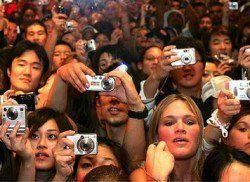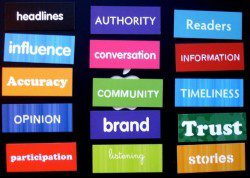This interview with Jennifer Preston, Social Media Editor at the New York Times, was conducted by my good friend, Olivier Cimelière, who translated and posted it on his fabulous blog Le Blog du Communicant 2.0. You can find the French version article here: “Journalistes osez les reseaux sociaux.” I benefited from the V.O. version and a visit with Jennifer at SXSW, to allow this publication here. Enjoy.
A Rapid Biography of Jennifer Preston
Jennifer Preston has worked as a reporter, editor and newsroom executive at The New York Times for nearly 20 years. I had the chance to do a fireside chat with Jennifer at the Netexplo Forum at UNESCO (Feb 14 2013).
In 2009, she was named the first Social Media Editor at The New York Times, charged with the task of defining the value of social media for Times journalism and working as an evangelist for using social media tools within the newsroom.
She now writes for The Times about the intersection of social media and politics, but she has focused her efforts in the last year working on a new form of social journalism. It is digital storytelling that combines original reporting, user generated content from social platforms and “old-fashioned” blogging for the home page of nytimes.com.
Jennifer is an author and has won several awards for investigative reporting, including the New York Press Club’s Gold Typewriter Award for outstanding public service for a series about the use of deadly force by off-duty police officers – a timely subject if we think about the recent Dorner case in California.
Jennifer Preston is also an adjunct professor at Columbia University’s Graduate School of Journalism. Aside from her wonderful personality and generosity, you will enjoy following her on Twitter @JenniferPreston, where you will observe that she has quite a following.
1/ In your eyes, how can crowdsourcing be instrumental for media companies? In other words, what are the opportunities?
Jennifer Preston: One of the most important lessons I learned from Martin Nisenholtz, former digital chief at The New York Times, is the value and importance of journalists taking on the role of curator. We are responsible for delivering the best original reporting and ideas for our readers and users. At the same time, we are also responsible for curating — for finding and pointing to — excellent content that is being produced by others, including content produced by our long-time competitors and ordinary people, long-called “citizen journalists.” (Jay Rosen and Clay Shirky, both professors at New York University, have been articulating the role of the crowd and citizen journalists for a longtime. To me, they are the two best thinkers in this space.)
Social media tools offer tremendous opportunities for media organizations to distribute content and engage with readers all over the world. For reporters and media companies, these tools offer ways to find sources at the scene of breaking news events. With cellphones, ordinary people are creating compelling content, photos and videos, that we can be easily found and integrated into our news reports. To ignore the witnesses on the ground and to dismiss the content they are creating
is a big mistake. Is the quality the same as that a professional photographer? Of course not. We continue to rely on the keen eye of professional photographers around the world; but, they are not always available. And everyone with a smartphone can be a photographer today and publicly share their work on social platforms. It is our job, as journalists, to find those photographs, sort through them to find the best, and to make sense of them, and publish, if appropriate, with the right context. We pay for photographs from amateur photographers in our paper.
Beyond breaking news, journalists can find excellent videos, images and information shared on social media platforms that can also help them report, tell and present multi-media visual narrative storytelling, without Final Cut Pro (the program that many people use to edit videos.) One of the most important lessons that every writer learns is the value of “showing” your reader as well as telling him or her. By embedding YouTube videos, images and posts from Twitter, writers and editors can help illustrate and add value to their storytelling.
That said, I am not in favor of blog posts that are made up of embedded posts on Twitter, let’s say, showing reaction to a certain event. On the New York Times LEDE blog, we strive to combine original reporting, with user-generated content, along with what I like to call old-fashioned blogging — linking to terrific ideas from other sources, including professional sources.
2/ What is the New York Times’ vision about User Generated Content (UGC) for breaking news and narrative storytelling?

Interactive word cloud created by the NYT where readers can drop in their messages on the different themes.
Jennifer Preston: I am not the right person to discuss company strategy. But I can tell you that The New York Times has engaged its readers for more than a hundred years. In our Opinion pages, we were the first newspaper in New York to invite Letters to the Editor from people who disagreed with the Editorial page’s position on issues. Beyond reader comments and sharing reader photos and videos in stories, we have been involving our readers in the creative process in all sorts of interesting ways.
We have asked readers to contribute in the context of a Moment in Times, where we have asked them to help create an interactive graphic, for example, with their ideas for Hope (2010); on health care policy reform; or to fix the budget.
We regularly ask our readers to send their photos and/or videos for various stories that we are working on and we incorporate them into beautiful presentations, as well as interactive graphics and articles. Andrew DeVigal led our multi-media efforts for years. He is a master. I learned, as all of us did, so much from him.
With social media tools, we have been able to find content created by people all over the world and integrate their images and videos into our storytelling. I hope that you will see more of this storytelling on other news organizations. I think that you will, with organizations, like Storyful.com, in the business of creating a social media news wire for media companies and Storify.com, helping give journalists tools to present.
All that said, the Times is committed to continuing to create the most original, stunning multi-media presentations, videos and interactive graphics — with our own amazing and talented staff of photographers, producers, videographers and editors.
If you haven’t checked it out yet, look at Snowfall. It is a whole new way of storytelling — not with UGC but with videos and a multimedia presentation that was created in-house. {MD: Snowfall is an absolutely a stunning story, magnificently presented… Talk about an Omigosh factor! Please do tweet this out!}
3/ How are you proceeding to foster buy-in and a mindset change among NYT journalists who might be reluctant or/and suspicious?
Jennifer Preston: As the newsroom’s first Social Media Editor, named to that position in 2009, I did not run into much resistance from my fellow journalists. In part, that is because I placed a heavy emphasis on the value of these tools for our journalism. I did not tell reporters that they all had to open a Twitter account and start tweeting. Instead, I showed how social media gave them powerful tools to do their job in a smarter way. I showed how social media tools can be used for reporting, for creating a personal wire service, using Twitter, for each beat and for helping journalists find sources, track trends and keep up with vital information in a time efficient way. For editors, I showed the value of these tools for real-time publishing and presentation. For example, in a big breaking story, we can share with our readers curated posts on Twitter from people at the scene as we are trying to move reporters and photographers to the location. This proved to be very useful during the earthquake in Haiti and the shooting in Fort Hood.
But, the first lesson for everyone in the newsroom about the importance of Twitter for learning about breaking news came when a gigantic airplane landed in the Hudson River, just a few blocks from our office. How did we know about it? Patrick LaForge, an editor on the Metro Desk and early adopter of Twitter, saw a photo taken of the plane, floating with passengers standing on its wings, posted on Twitter.

The episode of the plane landing in the Hudson River revealed to the NYT the importance of Twitter as a real-time source of information.
In 2013, I think that the big opportunity is for journalists to curate news video from social platforms and to make sure that whatever they present on their online reports and blogs gives mobile users the best reading experience — and opportunity to share.
Overall, I do not find many reporters objecting to using social media for reporting. And, now we have hundreds of journalists tweeting. When I became social media editor, I did not have a staff and so it was a challenge to scale change without a team. Honestly, that is one reason why I wanted to return to storytelling because I thought it might be easier for me to help create change by showing, rather than talking about it. We have some excellent news this year at The Times, in terms of resources for social media. Our social media efforts are now led by a terrific journalist, Sasha Koren, who is the deputy editor for Interactive Graphics. Sasha has finally been able to hire a team, about a half-dozen super talented people as social media producers, to help more of our journalists use these tools for reporting and presentation and so I am expecting great things in the coming year.
4/ What are the hurdles and pitfalls when it comes to aggregating and relying on people’s comments and contributions?
Jennifer Preston : My colleague, Sasha Koren, is in charge of our community efforts and she has taken a lot of steps to help improve the tools for our comment users and moderators. Unlike some media companies, we moderate comments. We have a new tool — the brain — that helps do an initial sift of comments, but we have a staff of moderators who read them before they are posted so we can make sure there is a high-level of conversation on our site. That said, we do not pre-moderate comments on our social media platforms. One of the important steps was to identify “trusted commenters.” {Please do tweet this out!} These are people we trust to post their comment without much fuss.
In regards to user-generated content from social platforms for storytelling, there are many considerations from intellectual property rights to ethics. We apply the same standards to UGC as we do any content that we produce. We go through a thorough verification process, applying all the rigor that we use for our overall reporting. We don’t post anything without checking it out. We consider information that we find on social platforms to be a tip, not a fact. {East to tweet this out!} This includes YouTube videos. Questions we pose include: Did someone edit important content out before posting? Who created it? What was their motive? Many politicians and advocacy groups are now sharing and creating content on social platforms. This can be useful for reporting, but journalists need to be wary that they do not simply publish someone’s online press release without critically thinking and reporting out all the information. We are very mindful and sensitive of copyright issues and so we are careful, for example, not to use photos or images from platforms without checking the terms of services. That means we can embed a photo from Twitter, using Twitter’s app, but we will not automatically post a photo created on Instagram without checking rights. And I would never use a photo from Flickr without checking rights.
Thank you to Olivier Cimeliere and to Jennifer Preston for this interview. And will be happy to make sure any further questions are covered in the comments!

















I very sporadically publish responses, although I looked through a large number of comments here on Interview of Jennifer Preston Social Media Editor at New York Times but had
a few questions for you if you wouldn’t mind.
Might it be just me or are a few of these comments appear to be as if they could be generated from brain
dead folks? As well, should you be blogging
on other different websites, Let me stay in touch with you.
Will you post a short list of all your social networking sites like your linkedin information,
Facebook page or twitter feed?
I very sporadically publish responses, although I looked through a large number of comments here on Interview of Jennifer Preston Social Media Editor at New York Times but had
a few questions for you if you wouldn’t mind.
Might it be just me or are a few of these comments appear to be as if they could be generated from brain
dead folks? As well, should you be blogging
on other different websites, Let me stay in touch with you.
Will you post a short list of all your social networking sites like your linkedin information,
Facebook page or twitter feed?